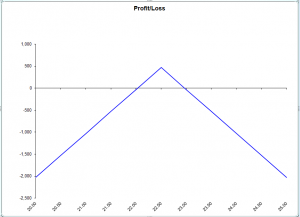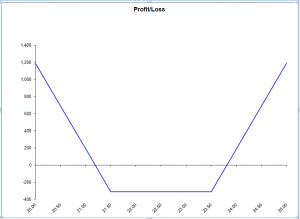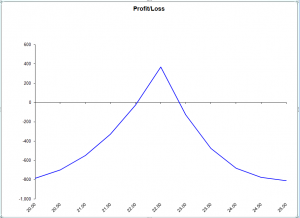Profiting from a Stock’s Relative Stability over a Given Period of Time

There are three situations in which options can be used to take advantage of changes in the price of an underlying stock: when prices rise, when they fall, and when they enter a relatively stable period. In this article, I will examine how to benefit from a relatively stable stock price. More specifically, we will look at an exchange traded fund (ETF) whose price is stable over a given period of time, establishing two spread strategies with different expirations. The first strategy involves selling a straddle with a short expiration, and the second consists of purchasing a strangle with a longer expiration.
For example, consider the option iShares S&P/TSX 60 ETF (XIU). On June 23, 2017 it is trading at $22.63. Let us say that we believe XIU will be relatively stable from now until an expiration in September 2017. We therefore decide to write a straddle on options expiring on July 21, 2017 with a strike price of $22.50. To this end, we carry out the following transactions:
Sale of 10 call options XIU 20170721 C 22.50 @ $0.31
Sale of 10 put options XIU 20170721 P 22.50 @ $0.16
Total credit = $470 [($0.31 + $0.16) x 100 units x 10 contracts]
Profit and loss diagram for selling the straddle on expiration on July 21, 2017

As shown in the above graph, selling the straddle allows us to make a profit if the price of XIU is stable or stays within the two breakeven prices of $22.03 and $22.97, achieving the maximum profit if XIU closes at exactly $22.50 per unit when the options expire on July 21, 2017. On the other hand, selling the straddle exposes us to significant losses above and below its breakeven prices. For example, if XIU closes at $20 or $25 per unit when the options expire on July 21, we stand to lose $2,000.
This is why we will implement a protective strategy, purchasing a strangle that will expire on September 15, 2017. The transactions for the strangle are as follows:
Purchase of 10 call options XIU 20170915 C 23.50 @ $0.09
Purchase of 10 put options XIU 20170915 P 21.50 @ $0.22
Total debit = $310 [($0.09 + $0.22) x 100 units x 10 contracts]
Profit and loss diagram for purchasing the strangle on expiration on July 21, 2017

As the above graph shows, purchasing the straddle generates substantial profits if the price of XIU starts to fluctuate, falling or rising significantly beyond the two breakeven prices: $21.19 and $23.81. The position will result in a loss if the price on expiration falls within the range of the two breakeven prices, generating a maximum loss of $310 between the two strike prices of $21.50 and $23.50.
The total profit and loss diagram is now as follows:
Profit and loss diagram for the total position on expiration on July 21, 2017

As this graph shows, we are still positioned to benefit from relatively stable prices for XIU, offering a potential profit as long as the price remains between the breakeven prices of $22.03 and $22.87 and giving a maximum potential profit of $368 if XIU closes at exactly $22.50 when the options expire on July 21, 2017. This figure is only an estimate, determined using the Black-Scholes formula keeping all the variables in the model relatively stable. It is only an estimate because it is based on the difference between the price of the options on September 15, 2017 (since on July 21 they will still be two months from expiration) and the price of our options expiring on July 21, 2017. As you can see, our maximum profit has dropped by approximately $100, but in exchange we have secured protection against large fluctuations in the price of XIU, either up or down. In the first graph our potential loss on XIU rising to $25 or dropping to $20 was $2,000, but now our potential loss is only $800.
The beauty of this strategy is that if the price of XIU is relatively unchanged when the options expire on July 21, 2017, we can take our profits and sell another straddle expiring on August 18, 2017. This new straddle will generate a credit that is more or less equal to the one we received from the July 21, 2017 straddle, and it will allow us to maintain our strangle. If the price of XIU is still relatively unchanged on August 18, 2017, we can sell yet another straddle expiring on September 15, 2017. So we are looking at making a maximum profit of three times $470, based on market prices (assuming that the variables in the Black-Scholes model remain relatively unchanged) by selling the straddle against the $310 debit on the purchase of the strangle.
Good luck with your trading, and have a good week!
The strategies presented in this blog are for information and training purposes only, and should not be interpreted as recommendations to buy or sell any security. As always, you should ensure that you are comfortable with the proposed scenarios and ready to assume all the risks before implementing an option strategy.
President
Monetis Financial Corporation
Martin Noël earned an MBA in Financial Services from UQÀM in 2003. That same year, he was awarded the Fellow of the Institute of Canadian Bankers and a Silver Medal for his remarkable efforts in the Professional Banking Program. Martin began his career in the derivatives field in 1983 as an options market maker for options, on the floor at the Montréal Exchange and for various brokerage firms. He later worked as an options specialist and then went on to become an independent trader. In 1996, Mr. Noël joined the Montréal Exchange as the options market manager, a role that saw him contributing to the development of the Canadian options market. In 2001, he helped found the Montréal Exchange’s Derivatives Institute, where he acted as an educational advisor. Since 2005, Martin has been an instructor at UQÀM, teaching a graduate course on derivatives. Since May 2009, he has dedicated himself full-time to his position as the president of CORPORATION FINANCIÈRE MONÉTIS, a professional trading and financial communications firm. Martin regularly assists with issues related to options at the Montréal Exchange.
The information provided on this website, including financial and economic data, quotes and any analysis or interpretation thereof, is provided solely for information purposes and shall not be construed in any jurisdiction as providing any advice or recommendation with respect to the purchase or sale of any derivative instrument, underlying security or any other financial instrument or as providing legal, accounting, tax, financial or investment advice. Bourse de Montréal Inc. recommends that you consult your own advisors in accordance with your needs before making decision to take into account your particular investment objectives, financial situation and individual needs.
All references on this website to specifications, rules and obligations concerning a product are subject to the rules, policies and procedures of Bourse de Montréal Inc. and its clearinghouse, the Canadian Derivatives Clearing Corporation, which prevail over the content of this website. Although care has been taken in the preparation of the documents published on this website, Bourse de Montréal Inc. and/or its affiliates do not guarantee the accuracy or completeness of the information published on this website and reserve the right to amend or review, at any time and without prior notice, the content of these documents. Neither Bourse de Montréal Inc. nor any of its affiliates, directors, officers, employees or agents shall be liable for any damages, losses or costs incurred as a result of any errors or omissions on this website or of the use of or reliance upon any information appearing on this website.
BAX®, CADC®, CGB®, CGF®, CGZ®, LGB®, MX®, OBX®, OGB®, OIS-MX®, ONX®, SCF®, SXA®, SXB®, SXF®, SXH®, SXM®, SXO®, SXY®, and USX® are registered trademarks of the Bourse. OBW™, OBY™, OBZ™, SXK™, SXJ™, SXU™, SXV™, Montréal Exchange and the Montréal Exchange logo are trademarks of the Bourse. All other trademarks used are the property of their respective owners.
© 2024 Bourse de Montréal Inc. All Rights Reserved.
